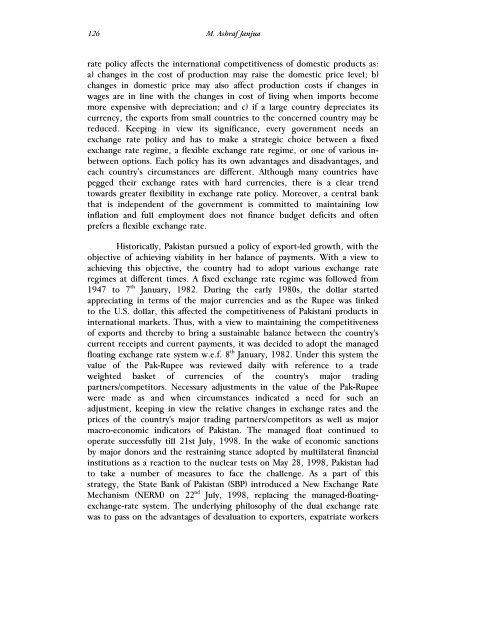Special Edition-07.pdf - Lahore School of Economics
Special Edition-07.pdf - Lahore School of Economics
Special Edition-07.pdf - Lahore School of Economics
Create successful ePaper yourself
Turn your PDF publications into a flip-book with our unique Google optimized e-Paper software.
126<br />
M. Ashraf Janjua<br />
rate policy affects the international competitiveness <strong>of</strong> domestic products as:<br />
a) changes in the cost <strong>of</strong> production may raise the domestic price level; b)<br />
changes in domestic price may also affect production costs if changes in<br />
wages are in line with the changes in cost <strong>of</strong> living when imports become<br />
more expensive with depreciation; and c) if a large country depreciates its<br />
currency, the exports from small countries to the concerned country may be<br />
reduced. Keeping in view its significance, every government needs an<br />
exchange rate policy and has to make a strategic choice between a fixed<br />
exchange rate regime, a flexible exchange rate regime, or one <strong>of</strong> various inbetween<br />
options. Each policy has its own advantages and disadvantages, and<br />
each country’s circumstances are different. Although many countries have<br />
pegged their exchange rates with hard currencies, there is a clear trend<br />
towards greater flexibility in exchange rate policy. Moreover, a central bank<br />
that is independent <strong>of</strong> the government is committed to maintaining low<br />
inflation and full employment does not finance budget deficits and <strong>of</strong>ten<br />
prefers a flexible exchange rate.<br />
Historically, Pakistan pursued a policy <strong>of</strong> export-led growth, with the<br />
objective <strong>of</strong> achieving viability in her balance <strong>of</strong> payments. With a view to<br />
achieving this objective, the country had to adopt various exchange rate<br />
regimes at different times. A fixed exchange rate regime was followed from<br />
1947 to 7 th January, 1982. During the early 1980s, the dollar started<br />
appreciating in terms <strong>of</strong> the major currencies and as the Rupee was linked<br />
to the U.S. dollar, this affected the competitiveness <strong>of</strong> Pakistani products in<br />
international markets. Thus, with a view to maintaining the competitiveness<br />
<strong>of</strong> exports and thereby to bring a sustainable balance between the country's<br />
current receipts and current payments, it was decided to adopt the managed<br />
floating exchange rate system w.e.f. 8 th January, 1982. Under this system the<br />
value <strong>of</strong> the Pak-Rupee was reviewed daily with reference to a trade<br />
weighted basket <strong>of</strong> currencies <strong>of</strong> the country's major trading<br />
partners/competitors. Necessary adjustments in the value <strong>of</strong> the Pak-Rupee<br />
were made as and when circumstances indicated a need for such an<br />
adjustment, keeping in view the relative changes in exchange rates and the<br />
prices <strong>of</strong> the country's major trading partners/competitors as well as major<br />
macro-economic indicators <strong>of</strong> Pakistan. The managed float continued to<br />
operate successfully till 21st July, 1998. In the wake <strong>of</strong> economic sanctions<br />
by major donors and the restraining stance adopted by multilateral financial<br />
institutions as a reaction to the nuclear tests on May 28, 1998, Pakistan had<br />
to take a number <strong>of</strong> measures to face the challenge. As a part <strong>of</strong> this<br />
strategy, the State Bank <strong>of</strong> Pakistan (SBP) introduced a New Exchange Rate<br />
Mechanism (NERM) on 22 nd July, 1998, replacing the managed-floatingexchange-rate<br />
system. The underlying philosophy <strong>of</strong> the dual exchange rate<br />
was to pass on the advantages <strong>of</strong> devaluation to exporters, expatriate workers

















